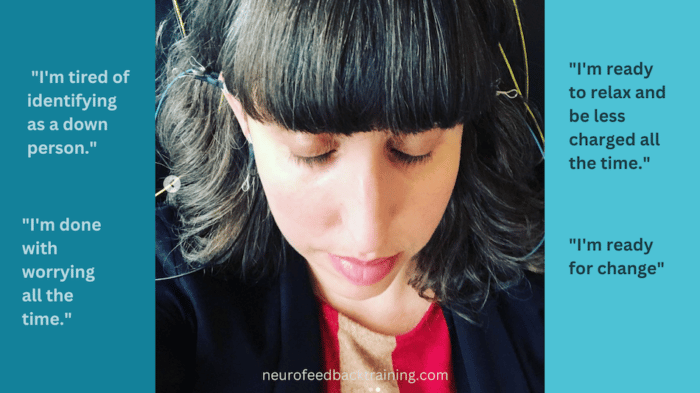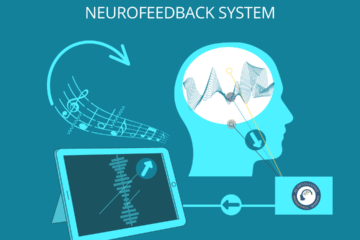Neurofeedback is an excellent support for those with anxiety. We have found that educating clients about how neurofeedback supports the anxious brain is key to the best outcomes.
Why education? The reason is because anxiety often creates a lot of doubt, fear and questions so we want to get you off to a good start with your training so first I want to define what anxiety is from the brain’s point of view, so that the conceptual understanding can be a reference point for you and understanding why NeurOptimal can help with anxiety.
Watch the video or read the transcript below
Your Brain on Anxiety (?)
Anxiety is the hyper-arousal response of the stress response. The stress response functioning is part of our more primitive brain, the limbic brain. You can also think about it as our survival brain. This response is what the brain does when it thinks there’s immediate, imminent, danger. Meaning, in less than a minute something could cause me bodily harm. The steps once “danger” has been identified is that the limbic brain shifts out of that state of regulation, which is perceiving safety, being calm, being alert but relaxed, and open, to being able to go into that fight/ flight energy to resolve the issue of whatever is dangerous.
Signs of being stuck in stress and anxiety
The brain’s next step is supposed to be to then come back into the regulated state. What we call anxiety is when the brain is habituated to staying in that fight flight or hyper arousal energy. What it looks like long term is that we’re in a chronic state of worrying. We’re always looking at life through the lens of what’s a problem. We’re not sleeping well we’re more easy to become reactive and irritable. If we’ve had anxiety since we were a child, often diagnosed as Complex PTSD, anxiousness also gets merged into our sense of self and our sense of self in relationship. As a result we have a hard time trusting and we have a hard time having confidence in ourselves or in others. The anxiety can infuse our self-talk and how we orient ourselves. We are looking at the world through the lens of how am I a problem. What’s going to go wrong. All of these characteristics are stemming from that brain being stuck in that fight/ flight energy.
Understanding the how-I-got-here is a very important thing because when you’re training with NeurOptimal® you’ll understand what is being addressed. What we’re doing is we’re showing that brain over and over again what it’s doing habitually so that anxious brain is going to see, “ Wow, I’m constantly in that hyperarousal and yet there’s no imminent danger! I’m sitting quietly in my home or I’m in an office. There’s nothing about to harm me.”
The theory of regulation is that the brain is going to naturally want to come out of that hyper-arousal and into a regulated state. And we experience that shift as the body becomes calmer, which for some people is a very new experience. And sometimes an unsettling experience. There is more self-awareness whereby they feel their bodies more vividly. Their bodies feel a little heavier. It is not going into a state of depression, which is often what some people will assume when they start to really live in a state of regulation. Sometimes clients mistake this as depression. And it is part of why we educate, so that when they feel calmer, they can understand it is a good thing, unfamiliar but good.
Preparing for success is to anticipate and talk to yourself about how it’s okay to be calmer and how it’s okay to not always be in worry mode or in go-mode. There is that quality with anxiety where we’re kind of perched all the time, mentally. We’re sitting on the edge of our chairs and anticipating. We’re feeling like we always have to be doing and so when we’re in a state of regulation we’re more in a state of being. There is a readiness to do when we need to, but it takes a lot of energy to stay in that state of dysregulation so the brain is naturally going to want to come out of that state and live more in that regulated state of calm readiness.
A sign of anxiety are the questions people ask before starting training: is this going to work? When will I see results? What if I don’t see results? The set-up is to anticipate a big problem before they start sessions. For this reason, when you are doing neurofeedback to help with anxiety, we strongly encourage clients to fill out the tracking results checklist in the beginning and every 10 sessions. And to rely on the numbers changing each time to show them what is shifting and not use their worrying mind.
The checklists we created rate a whole body of symptoms and issues on a scale of one to ten. There is also a personalized checklist where clients rate the issues of greatest concern on a scale in terms of frequency, intensity, and duration. Because the brain is going to shift itself we are creating the circumstances for us to see the shifts through filling out the checklists without referring back to the initial ones. It allows for a fresh assessment. Then afterwards, one can fill out another checklist and compare the two. This is when we want clients to address the question: how is this working for me?
When you set yourself up to constantly be asking that question every single time you do a session you’re creating that anticipatory energy that fight/ flight energy. Instead using the checklist strategy and telling oneself to not follow the worrying thoughts about whether it’s working then you’re setting yourself up to be calmer and to just do your sessions.
How many neurofeedback sessions are needed for anxiety?

I want clients to move away from the idea that there is the one thing that fixes us and to look at the problem in a more nuanced and holistic way. We are introducing a brain support with neurofeedback to help the individual change maladaptive patterns that are both on an unconscious brain level and a conscious thought and beliefs level.
One indicator of a slower process is if your sense of self is enmeshed with that anxiousness. Another factor is how ready you are to be calm and to be able to be open and value the calm/open state. Those who can recognize that regulation is a good home base tend to shift faster. People who are very ambivalent about their go-mode and what function that fight/flight energy serves usually somewhere around eight sessions, when they start to feel really calmer more consistently, that’s when they start to get fearful. Their fearful thoughts create ideas like they’re not going to get things done, or they’re going to lose motivation. That readiness to identify as a calm person is very helpful in terms of staying the course with the sessions.

The other point I want to make about what gets in the way of people having success when training with anxiety is how the brain actually changes. We often think about positive change in a linear way, which means it’s predictable and it’s constantly moving in the same direction. For example, having the expectation that every day I will feel a little bit better and then I know I’m on the path of success and it’s working. The problem with this expectation is that the brain is a non-linear system. It does not change in a linear, predictable pattern. A common non-linear system that we’re familiar with is the weather. If we have a dump of snow in April we don’t automatically lose trust in the weather and assume spring and summer aren’t going to happen. That assumption of regression is something people think when they’ve been brain training and noticing some positive shifts and then they have a spike in an anxious feeling and then they go “oh my God the training is not working” or “I did something wrong!” The answer is “no you’re fine!” It’s just that the brain changes in a non-linear fashion so you’re going to have occasional spikes in the old feeling states but over time you’re going to notice that in the duration, intensity and frequency those anxious habits are going to shift. They’re just not going to look in a perfect linear way.
When you’re doing neurofeedback there are lifestyle factors that can either help that process or make it more difficult. Some of the other supports to consider are exercise, even a rigorous walk 20 minutes a day has health benefits for the brain. It’s been proven to help mood in so many studies it is no longer even question as to the benefits for mood. Exercise helps the brain function well, in part by increasing blood flow to the brain. Other lifestyle factors to look at over time are diet. How often do I eat? How much processed and sugary foods and drinks? How much caffeine and alcohol? The other big one is sleep. We know alcohol and eating late affect the quality of sleep. Lack of a good sleep routine is another contributor to poor quality sleep.
While these are other variables to eventually add, starting with neurofeedback is effective. It creates a ground of regulation and that regulated brain, which is calmer and better able to focus and track information, can then add other changes with higher degrees of success.
There are lots of variables that support brain health so neurofeedback being one very helpful, and very important piece but just to know that over time you might want to start with the neurofeedback knowing you want to add things like a little bit more exercise, a little less media consumption, over the day or specifically in the evening. You know looking at your diet. Again, starting with the neurofeedback which is going to help create a good ground and knowing that you could add those things over time so certainly we see a lot of success with people who are brain training to help support their systems re-regulate out of anxiety but it is a process and it does take months and so setting yourself up with that expectation of the time frame is also really important.
**NeurOptimal® is a training tool and does not diagnose, treat, mitigate prevent or cure any disease, disorder or abnormal physical state, nor does it restore, modify or correct the body’s structure or functioning. If you require medical assistance, please seek the advice of your physician. NeurOptimal® is designated by the FDA as a General Wellness Product based on its safety and intended uses.


